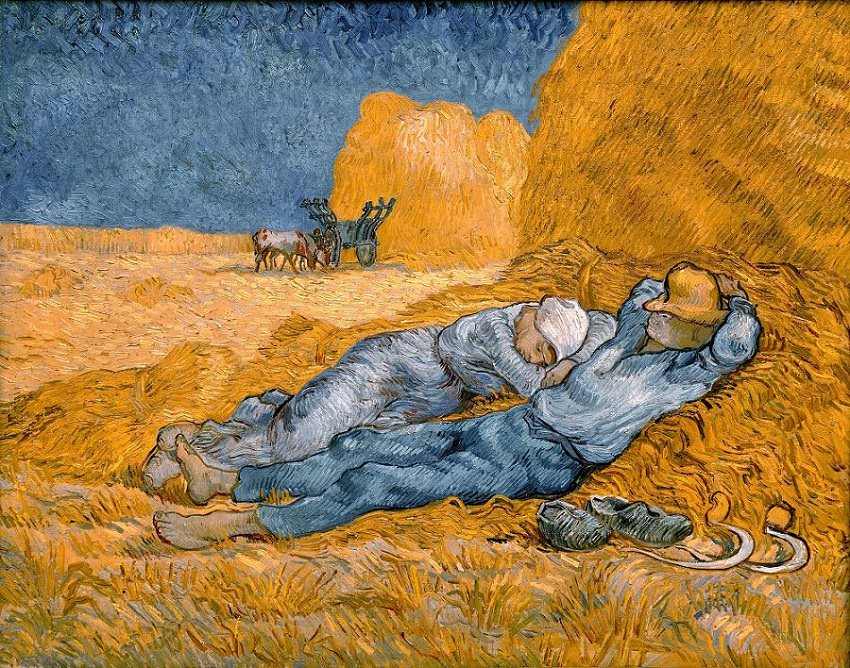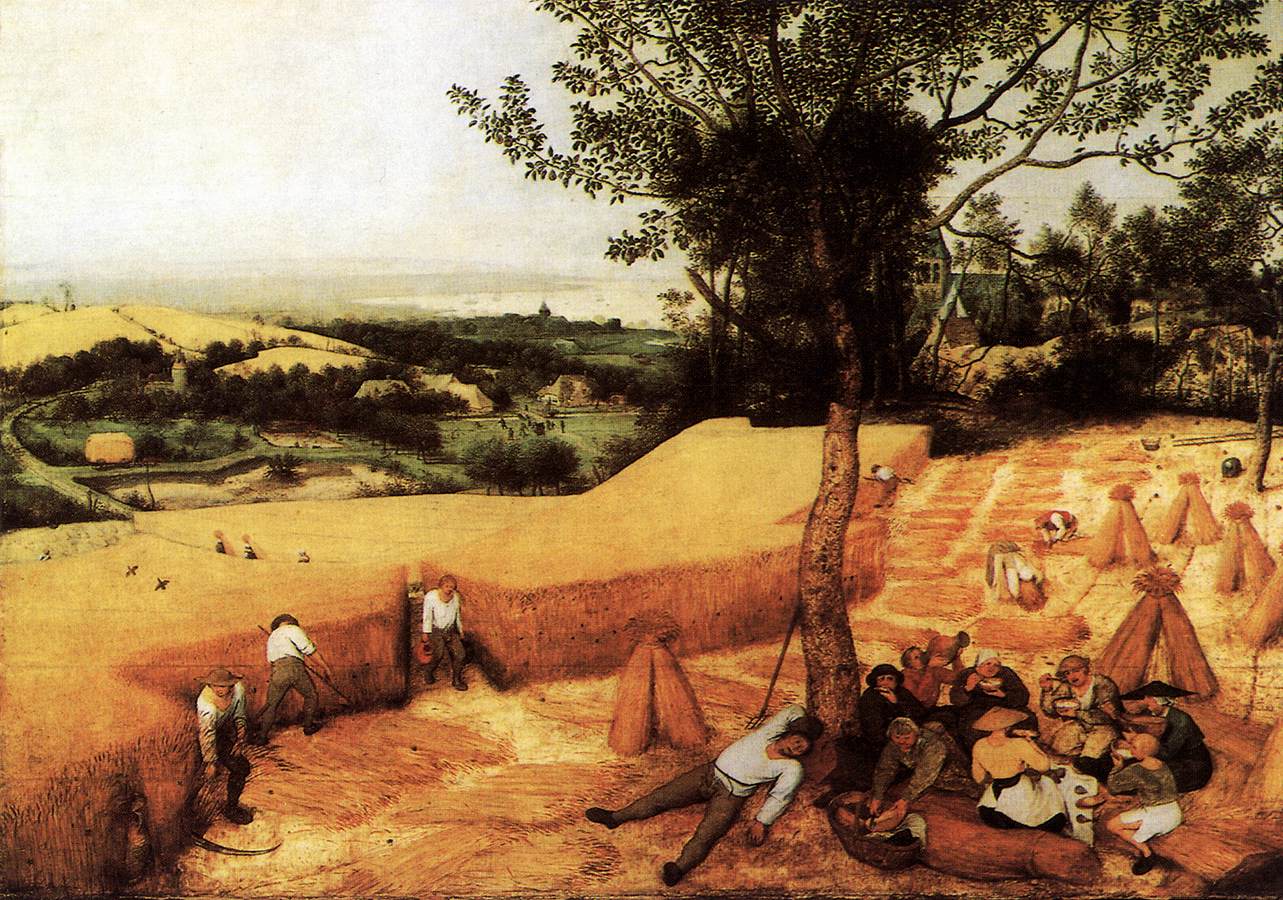
(Van Gogh’s “Noon-day Rest”, 1890)
The summer heat is upon us, so it’s time for this blogger to keep cool, read those wonderful books on the ever-growing list, and practice Bach solo suites. I will be back in touch in September, when the rains come again! In celebration of summer, I leave you with an ekphrastic poem by William Carlos Williams ‘The Corn Harvest’, a response to Brueghel’s painting included in his seasonal series (which includes the ‘Hunters in the Snow’, the topic of one of our earlier discussions.

Pieter Brueghel, “The Corn Harvest” (1565) Metropolitan Museum of Art, NY
Brueghel’s artwork depicts the summer activities of working peasants. The visual center of the painting is occupied by a young worker who is sleeping under a tree, and nearby and to the right we see a group of women who are seated on the ground, eating their mid-day meal. To the left of this section, a worker is leaving the wheat field while another is cutting wheat, and still another who has discovered a wine jug hidden among the stalks. The field, over which two large blackbirds hover, extends into the painting’s background, where it converges with the green landscape surrounding a small community. Most of these details have been ignored in the poem, but still Williams has managed to capture what is most likely the central concern of the painting.
The Corn Harvest, William Carlos Williams
Summer !
the painting is organized
about a young
reaper enjoying his
noonday rest
completely
relaxed
from his morning labors
sprawled
in fact sleeping
unbuttoned
on his back
the women
have brought him his lunch
perhaps
a spot of wine
they gather gossiping
under a tree
whose shade
carelessly
he does not share the
resting
center of
their workaday world.
(Collected Poems II, 389)
By capturing Brueghel’s painting in his title and by pointing out in the second line that ‘the painting is ‘organized’, Williams reminds us that we are viewing, through his poem, a work of art which is a carefully constructed artifact. Having thus established the ekphrastic context of the poem Williams proceeds in the following 10 lines to focus on the physical center of the painting: ‘a young / reaper enjoying ‘ his noonday rest …’. The line following may be read in two ways: the young man is either enjoying his rest ‘completely’ or is ‘completely / relaxed’. Whichever way we choose to read the ambiguity in these lines, perhaps most important here is the kind of rest the poem implies. Williams communicates this through the organization of the poem’s details. Having given the first half of the poem to the pictorial center of Brueghel’s painting, Williams introduces, in the second half, a ‘resting center’, which refers to a subjective space in the painting. Here, the broken syntax of the final 5 lines (whose shade / carelessly / he does not share the /resting center of / their workaday world/) creates an ambiguity that influences our interpretation or understanding of the poem: the ‘rest’, which is related to productive labor, may be seen as one in which the young reaper does not partake. On the other hand, these lines may also indicate that the reaper is the resting center of the otherwise busy harvest scene. Through the use of these line breaks, Williams lets us choose. Jerome Mazzaro, for example, has suggested that the young man, who has overeaten and perhaps drunk too much, projects the kind of ‘dreamy silence (which) in Williams is everywhere attacked as being ineffective (non-action producing), sentimental, and false. 1 If this is so, then this would very likely be reflected in the elements that Williams selects from the painting.
Although Williams focuses almost exclusively on this single image and appears to ignore the rest of the elements in the painting, he does set up one important (and perhaps the primary) opposition by dividing the poem in this way. Both ‘centers’ depict resting, yet that of the women is the kind that follows hard work; the other is one which sprawls ‘carelessly’ and ‘unbuttoned’ on its back. Looking at the painting itself, the half-revealed jug of wine in the left-hand corner might be a clue that the young reaper has indeed been drinking too much, as Mazzaro suggests. But even without this clue, the physical opposition between the two different sorts of resting makes this clear. As Dundes and Stibbe have pointed out, in Brueghel’s paintings ‘one term of an oppositional pair without its complementary term is meaningless’. 2 This means that if Williams had intended to ignore the ‘foolish peasant’ moral (which we discussed in an earlier chapter on Brueghel’s peasants), in order to merely depict a genre scene, then his structural division in the poem wouldn’t make sense. Furthermore, even though the reaper’s ‘dreamy silence’ is not directly attacked in the poem, Williams has separated it structurally from ‘effective rest’. In this way, the young reaper is isolated in the poem both spatially ad semantically and even if Williams seems to neglect most of the signature oppositions which Brueghel placed in his paintings, particularly in the painting’s division into work and play, it is this kind of structural division in the poem that suggest that Williams really does intend to separate one from the other. By looking at the poem in this way, we can venture a guess that Williams intends to project the same kind of irony towards peasants that we find in this and other Brueghel’s paintings.
This is the joy of reading a poem from an ekphrastic viewpoint. I will add another section here, under ‘ekphrastically speaking’, for those who might be interested in applying my Differential Model (Chapter 6) to this poem (you might try it yourself first).
1. Joel Connoroe, ‘The Measured Dance: Williams’ “Pictures from Brueghel”‘, in Journal of Modern Literature 1, (May, 1971), p. 572
2. Alan Dundes and Claudia Stibbe, The Art of Mixing Metaphors: A Folkloristic Interpretation of the ‘Netherlandish Proverbs’ by Pieter Brueghel the Elder (Helsinki: FF Communications: Academia Scientiarum Fennica, 1981), p. 67.
Next Postings will continue consideration of illustrating poetry (in the Autumn)
If you want to spend your time thinking about our topic (Illustrating poetry), then I highly recommend that you read The Victorian Web, most specifically everything on Pre-Raphaelites (if you haven’t already done so). You might also like to read Mary Wollstonecraft’s ‘A Vindication of the Rights of Woman’ (1792; one of the earliest feminist tracts).
The first poem that we will explore is ‘The Lady of Shalott’. You can find this poem on the Victorian web: http://www.victorianweb.org/authors/tennyson/los1.html
For a general discussion on Pre-Raphaelites, please go to http://www.victorianweb.org/painting/prb/index.http. Here are the topics of interest that you will want to read (actually, you will want to read it all! It’s addictive!):
Introduction
Pre-Raphaelitism: A Chronology
The Complex Nature of Early Pre-Raphaelitism: Five Strands
The Pre-Raphaelite Brotherhod and Symbolic Realism
Ruskin, Tintoretto, and the Language of Types
New chemistry, new colors — scientific discovery and Pre-Raphaelite painting
Pre-Raphaelite Women Artists
Aesthetic Pre-Raphaelitism
Art in Evolution: The Association of Burne-Jones, Morris, and Rossetti in the Second Generation of Pre-Raphaelitism
The Redgrave Brothers on the Pre-Raphaelites — a somewhat askew account of 1890
The Pre-Raphaelite Body
Existe-t-il un style Preraphaelite?
Artists and Literary Relations
Pre-Raphaelites, Associates, and Later Followers — Sitemap
Pre-Raphaelitism — Literary relations: Sources, Influences, Confluences — Sitemap
Genre in Pre-Raphaelite Painting
Genre — Sitemap
General Cultural Contexts
Victorian Political History — Sitemap
Victorian Social History — Sitemap
Themes, Concerns, Reception
Pre-Raphaelites — Theme and Subject — Sitemap
Religious Themes and Contexts — Sitemap
Gender Matters — Sitemap
The Pre-Raphaelites, Design, and the Decorative Arts — Sitemap
The Art-Journal, 1850-1880: Antiquarians, the Medieval Revival, and The Reception of Pre-Raphaelitism
Bibliography, exhibitions, book and exhibition reviews, discussion topics and related Web Resources
Reviews of books about the Pre-Raphaelites and exhibitions of their works
Twentieth- and twenty-first-century exhibitions of Pre-Raphaelite work
Bilbliography
Leading Questions
Symbolism
Well, this should keep everyone busy for the time being!
